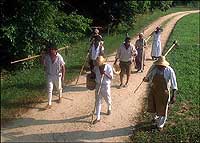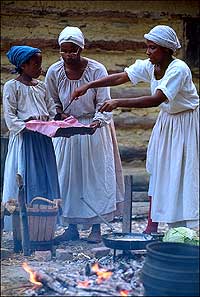Page content

Historical interpreters shoulder their tools and head for a day of labor in the fields as slaves would have done in colonial times.
Introduction to Colonial African American Life
Slavery existed in every colony
At the dawn of the American Revolution, 20 percent of the population in the thirteen colonies was of African descent. The legalized practice of enslaving blacks occurred in every colony, but the economic realities of the southern colonies perpetuated the institution first legalized in Massachusetts in 1641. During the Revolutionary era, more than half of all African Americans lived in Virginia and Maryland. Most blacks lived in the Chesapeake region, where they made up more than 50 to 60 percent of the overall population. The majority, but not all, of these African Americans were slaves. In fact, the first official United States Census taken in 1790 showed that eight percent of the black populace was free. [Edgar A. Toppin. "Blacks in the American Revolution" (published essay, Virginia State University, 1976), p. 1]. Whether free or enslaved, blacks in the Chesapeake established familial relationships, networks for disseminating information, survival techniques, and various forms of resistance to their condition.
Slave labor required for farming and tobacco cultivating
The majority of blacks living in the Chesapeake worked on tobacco plantations and large farms. Since the cultivation of tobacco was extremely labor-intensive, African slave labor was used, despite questions of whether slavery was morally right. Tobacco cultivation rivaled the sugar production of the British West Indies. Tobacco was an eleven-month crop. Cultivation began in late January with the preparation of the fields for planting, mending tools, and laying out the seed beds. Once the soil was ready (usually in March), tobacco seedlings were transplanted to the fields. By mid summer, tobacco was growing in the fields, but the delicate plant required constant care. At harvest time, tobacco was gathered and prepared for its shipment to England.
Plantation and farm slaves tend crops and livestock
For slaves working on farms, the work was a little less tedious than tobacco cultivation, but no less demanding. The variety of food crops and livestock usually kept slaves busy throughout the year. Despite the difficult labor, there were some minor advantages to working on a plantation or farm compared to working in an urban setting or household. Generally, slaves on plantations lived in complete family units, their work dictated by the rising and setting of the sun, and they generally had Sundays off. The disadvantages, however, were stark. Plantation slaves were more likely to be sold or transferred than those in a domestic setting. They were also subject to brutal and severe punishments, because they were regarded as less valuable than household or urban slaves.
Few men on domestic sites
Urban and household slaves generally did not live in complete family units. Most domestic environments used female labor; therefore there were few men, if any, on domestic sites. Most male slaves in an urban setting were coachmen, waiting men, or gardeners. Others were tradesmen who worked in shops or were hired out. In general, urban slaves did not have the amount of privacy that field slaves had. They lived in loft areas over the kitchens, laundries, and stables. They often worked seven days a week, even though Sunday's chores were reduced. Their work days were not ruled by the sun; instead, they were set by tasks. But there were advantages to working in town.
Urban and domestic slaves usually dressed better, ate better food, and had greater opportunity to move about in relative freedom. They also were go-betweens for field slaves and the owners. They were privy to a great deal of information discussed in the "big house." They knew everything from the master's mood to the latest political events. The marketplace became the communal center, the place for "networking." At the marketplace, slaves would exchange news and discuss the well-being of friends and loved ones. They often aided runaways, and they kept a keen ear to those political events that might have had an impact on their lives. Regardless of a slave's occupation, there was considerable fear and angst caused by an environment of constant uncertainty and threats of violence and abuse.
Slavery a part of 18th-century Virginia society
Slavery was an integral part of 18th-century Virginia society. Attitudes and class structure legitimized a slave system based on color of skin; slavery touched virtually all aspects of life in 18th-century Virginia. Beginning with the arrival of the first Africans at Point Comfort in 1619, an initially unplanned system of hereditary bondage for blacks gradually developed. Over the course of 150 years, slavery became entrenched in Virginia society, increasingly supported by a series of restrictive laws and reinforced by the teachings of the community and family.
Slavery was the foundation of Virginia's agricultural system and essential to its economic viability. Initially, planters bought slaves primarily to raise tobacco for export. By the last quarter of the 18th century, wealthy Virginia farmers were using slave labor in a diversified agricultural regime. Enslaved African Americans also worked as skilled tradesmen in the countryside and in the capital city of Williamsburg. Many also served as domestics in the households of wealthier white Virginians.
The constant interaction between black slaves and white masters (as well as blacks and whites in general) created an interdependence that led to the development of a distinctive Virginia culture. That interdependence was as destructive as it was unequal. The horrors endured by enslaved African Americans, whether physical or mental, were numerous. White Virginians were caught up in a system that measured social distinction based upon ownership of slaves. Economic reliance on slavery, fears about the consequences of emancipation, and unyielding racial prejudice and cultural bias all contributed to the continuation of slavery in an era of independence.
Learn more:

